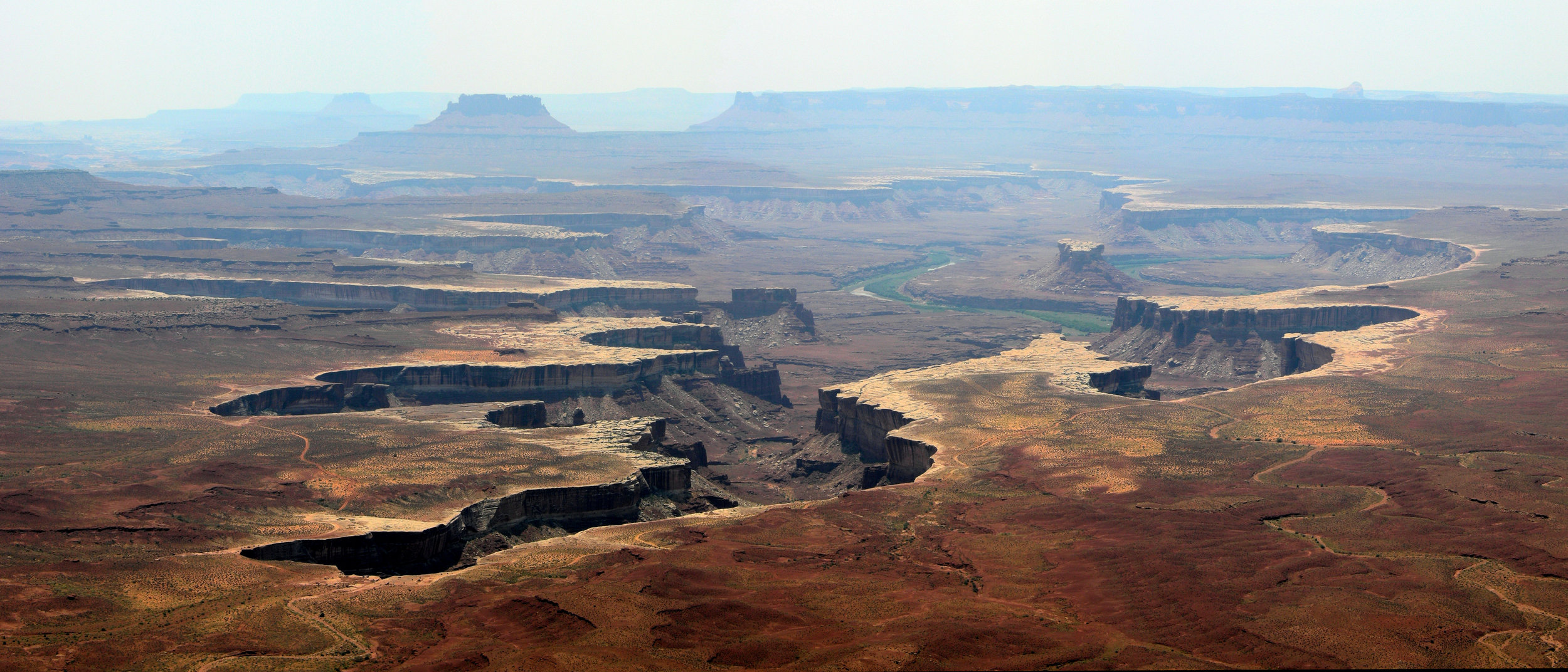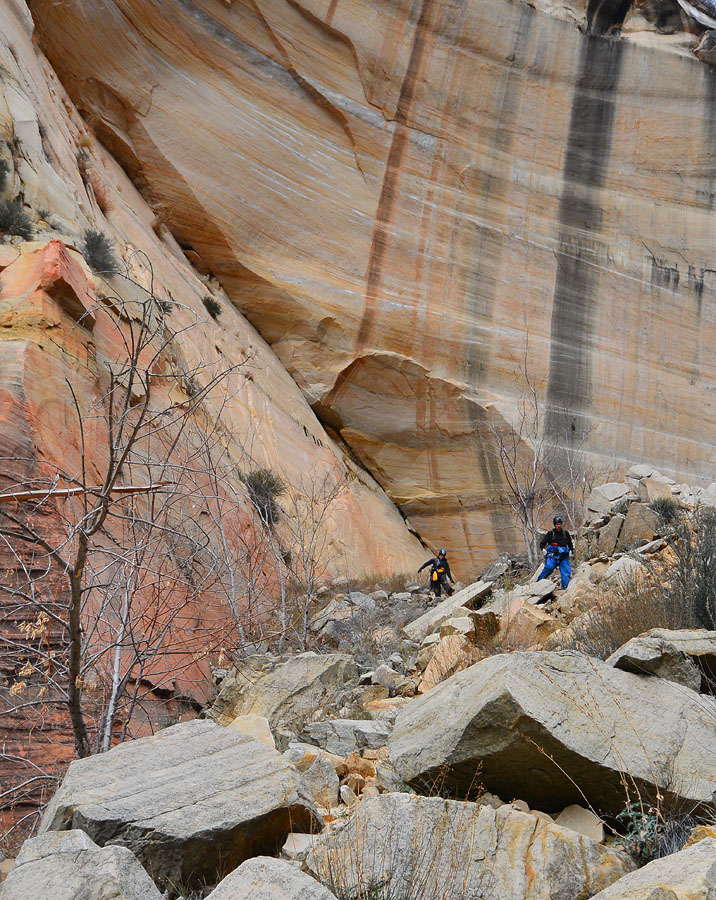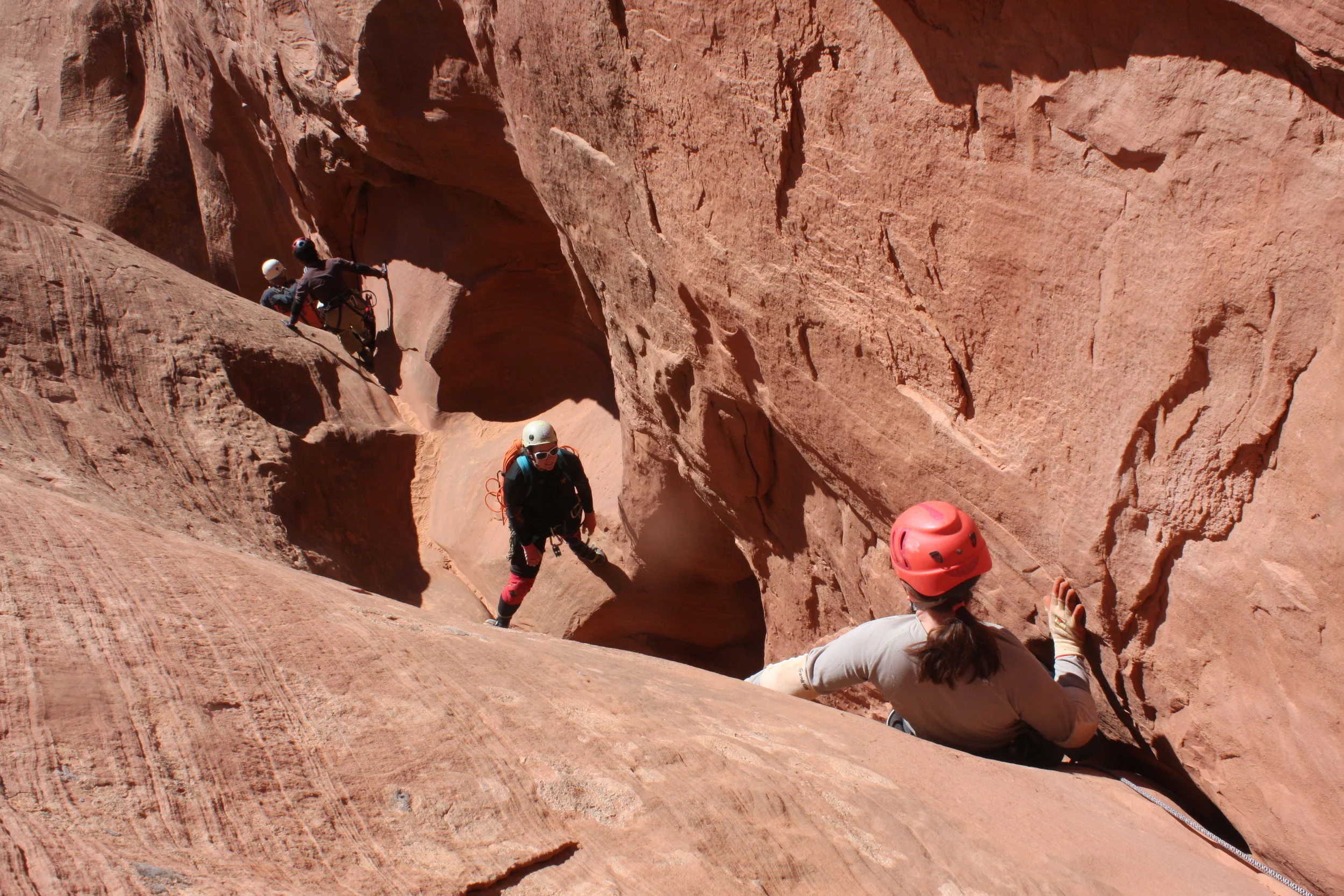
The Utah backcountry is a wild and uncontrolled place. This is good. But there are lots of ways of getting yourself in trouble, and a prudent visitor will be prepared to manage the risks. Managing the following hazards well will enable you to return for more fun.
Flash Floods
Flash Flooding is an important problem for every canyoneer to understand. Almost every adventure has some element of Flash Flood Danger; the key thing to understand is floods are predictable and avoidable. Since this is an important and rarely analyzed subject, I shall spew forth in detail:
Here's how Flash Floods work:
One of those impressive late-summer thunderstorms builds up, sucking all the moisture into the sky, making huge, grand and impressive thunderheads.
The thunderstorms get too big, too tall, "overdeveloped." The thunderhead collapses, and all that moisture falls out of the sky in an amazingly intense rain, often accompanied by hail.
The storm drops a very large amount of water over a small area, in a small time. The desert soil, baked by the summer heat, does not absorb much of anything, and the water runs off.
Runoff collects in gulleys, which lead to washes that lead to canyons. Because water runs faster when deeper, the water collects into a bit of a leading wave. Downcanyon, we hapless hikers are trapped in the narrow canyon when the water reaches us, concentrated by the narrow canyon walls. Death or discomfort occur.
It need NOT storm where you are to flash flood the canyon you are in, it only needs to storm somewhere in the watershed above you. This can be quite a distance. For example, in the San Rafael Swell, the lower part of Eardley Canyon/Straight Wash is fed by a large area near I-70, up to 12 miles away; in another especially difficult case, the Chute of Muddy Creek is fed by Upper Muddy Creek, which has a very large collection area from the central Swell to the Wasatch Plateau, 50 miles away. Bluebird skies above may provide no hint of the storm cell pounding the distant headwaters.
A flash flood does not arrive in one big wave, like on TV. Instead, it tends to arrive in numerous small waves, building quickly to a massive, churning maelstrom. I once just missed seeing the Muddy River rise from 1 foot deep and 15 feet wide to 6 feet deep and 30 feet wide, charging like a mad locomotive with big trees churning up and down - all in 15 minutes! Yikes! I almost spent the night across the river in my shorts and sandals, and some friends were almost swept away in the middle of the night. In that case, the thunderstorm was many miles away and a couple hours earlier.
Protecting yourself from hazards is YOUR responsibility.
Sound risk management is a major part of canyoneering ethics.
Protect yourself from flash flooding: Be smart.
During certain times of the summer (May-October), an annual weather pattern sets up bringing moist air in from the Pacific off Mexico, and big thunderstorms form almost every day. This is known as 'The Monsoon'. Pay attention to the weather forecast. Pay attention to the sky.
Do NOT go Canyoneering during the Monsoon.
Do NOT go Canyoneering when there are big thunderstorms forming.
That's pretty much it. It is pretty easy to predict that it WILL thunderstorm, but difficult to predict exactly where. But you don't really need to know that. Basically, you can predict with fair certainty, that 3 or 4 canyons will flash somewhere in the Swell. Now, call me timid, but knowing that, I'm heading to Ray's Tavern for a day of shooting pool and $1.50 Bud longnecks, rather than playing Canyoneering Roulette with Mr. Thunderstorm.
Some Flash Flood Rules of Thumb:
If the Thunderheads are already forming by noon, things are going to be bad.
If you cannot see through the rain falling from a thunderstorm, it is strong enough to create a flash flood.
Once the rain begins, flash flood conditions can develop in less than 5 minutes.
If your inner gut says 'no', listen to it. Go do something else.
However high you think you need to be to be safe from the flood, go at least twice as high.
If getting caught, do not try to outrun the flood unless you are very close to the end. Instead, find a place where you can climb out of the canyon or to a secure place HIGH on the canyon wall.
When camping in a narrow canyon, camp high above the canyon floor, above any signs of previous floods. Camp somewhere with safe pathways to go higher if needed.
Read more about flash flood examples and stories, below.
Canyoneering Hazards
Getting lost & getting in over your head

Getting Lost
Use a map
Several options exist for maps, including my canyoneering maps, and the more detailed USGS quads.
Getting lost is surprisingly easy. I used to do it myself, unfortunately, on a regular basis. Navigating off landmarks does not work very well in the desert, because a lot of it looks the same. So take maps, and keep track of where you are. Get a GPS and learn how to use it. My canyoneering maps are helpful if you have the tools to print them, but the USGS Quads have more information including: UTM coordinates, information off the edge of my maps in case your plans change, and more context.
Getting In Over Your Head
This is so common, it seems to be a southern Utah sport. Basically, you can't wander around in the desert with minimal gear and information and not get into serious trouble at least once in a while. KNOW BEFORE YOU GO. Do research, be cautious, be smart, keep track to where you are on the map, and THINK! You are taking the first step by reading this. Respect what I say, carry the recommended gear and know how to use it. Don't attempt routes you are not ready for. Hook up with people more experienced than you and learn how to do things right.
Canyoneering Hazards
Heat-related illness

Heat exhaustion, dehydration, and heat stroke are serious.
The desert is unforgiving and it gets damn hot. Dehydration, heat exhaustion, heat stroke, and sunburns are all among the hazards faced by anyone exploring in the Utah deserts. Typical hiking days require 4 quarts of water to stay reasonably hydrated. In the shade. Some routes cannot be done in hot weather, because staying in the bright desert sun for many hours is literally life-threatening, even with a lot of water, sunscreen and protective clothing. You can learn more about the signs and symptoms of heat-related illness here.
In addition to carrying and drinking plenty of water, use good desert hiking technique:
Stay in the shade whenever possible. Use sunscreen early and often.
Take a mid-day siesta in the shade, allowing the hottest part of the day to pass.
Get up early. Plan your hike to avoid getting sun-burned and dried out.
Be aware of your vital signs. When you need to escape the sun, do so.
Set a deliberate pace. Do not over-exert, keep things mellow.
Canyoneering Hazards
Getting hurt, Needing rescue

Injury & Wilderness Medicine
This is not Disneyland. ANY injury can rapidly become a serious problem. Assistance is usually many, many hours away. While being super-cautious is no fun, getting hurt is not an option. Use your noggin’ and don't do foolish things. OK?
That said, if you spend enough time canyoneering, eventually you, or someone in your party, WILL be injured. Hopefully, it will be as simple as a broken wrist or sprained ankle. When this happens, it is helpful to know how/what to do with typical backcountry supplies, so Wilderness First Responder training is a great idea for anyone who spends significant time in the backcountry. Wilderness Medical Associates, Wilderness Medicine Institute, and/or SOLO provide excellent training throughout the U.S. and beyond.
Wound Care
Hopping in and out of potholes tends to be hard on the skin, especially on the knees and hands. Little wounds can easily pick up an infection from the soup we are wading through. Keep a tube of Bacitracin ointment in the car, and clean up the day's wounds while waiting for your dinner to cook. Wearing neoprene kneepads helps, too.
Canyoneering Hazards
Technical Canyoneering

Managing your risk
Technical Canyoneering is, by it's very nature, hazardous. Once you start down that canyon, hit that first rappel and pull the rope, you have committed to making it down the canyon. You better know what you are doing. Here are some suggestions:
Don't be Stupid. Know your limits and stay within them. Bring the required equipment, no cutting corners. Bring the maps and the descriptions, and follow along in your guide so you know where you are. Don't think that just because there is an anchor, the route must be easy.
Getting Stuck is not an option. Good judgement, climbing and canyoneering techniques are all important to keeping it together. More info on this is available under the Technical Notes.
Tell Someone where you are going. Set up a check-in time, and provide information to your contact so the rescue squad knows where to start looking.



